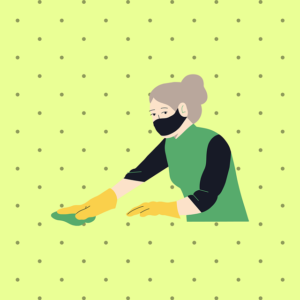Can You DIY Mold Remediation?
If your home has a moisture problem, you’re bound to end up with a mold problem, too. Mold poses serious risks to your health and the structural integrity of your home, so if you notice it building up, you’re going to want to act fast. But you might be wondering: can you DIY mold remediation?
Simply put, there is no substitute for professional mold remediation. A consultation and treatment from experienced professionals is the best way to get the source of the problem and ensure that mold will not continue to crop up in the future. However, in a pinch, there are some steps you can take to mitigate the harmful effects of mold. You just have to take the right precautions and use the right tools. Here’s what you need to know.

There’s no substitute for professional remediation. But is there anything you can do yourself if you have a mold problem?
Protect Yourself
Don’t make the mistake of downplaying the danger of mold. Mold may be commonplace, but that doesn’t mean it can’t hurt you. Contrary to popular belief, mold does not cause cancer or lung disease. But it can certainly irritate the respiratory systems. Some people may have a mold allergy and be more sensitive to it than others. If you’re still not convinced, read up on mycotoxicosis—a term that encompasses all the adverse health effects caused by mold.
With this in mind, you’re going to want to protect yourself from the mold. These days, just about everyone has a mask lying around the house. A cloth mask is better than nothing, but an N-95 respirator is best. You’re going to want gloves. As a final precaution, consider using goggles to prevent mold spores from entering your eyes.
What You Will Need
Now that you’ve protected yourself, arrange your cleaning product. You may have heard that bleach effectively eliminates mold, but it could end up doing more harm than good. Bleach just changes the color mold; it doesn’t kill it. It’s also a harmful chemical in its own right, and may best be avoided.
Instead, look into commercial mold removers such as borax. But a variety of other substances you have lying around the house could do the trick as well. Tea tree oil, for instance, is well-known for its antifungal properties. Hydrogen peroxide, baking soda, and vinegar are other substances that might work. For hard surfaces, you’re going to want a sponge (to be disposed of immediately afterward) or brush. If you’re dealing with drywall, just use a cloth or the soft side of a sponge.
Cleaning
Before approaching the mold, do whatever you can to increase ventilation in the area. Perhaps you can open the window or use a fan to help circulate the air. Ideally, you would use both. Now, simply clean as you would anything else. Leave it on the moldy surface for at least an hour, then wipe it off. Now, you need to make sure to dry the surface is completely dried. Ventilation will help, as will dehumidifiers.
But remember: this is just a temporary measure. Professional mold remediation is necessary to diagnose the cause of the problem, and eliminating the chance of it appearing again. If you don’t, you’re just risking coming into contact with mold again in the future.
Contact All Aspects Waterproofing Today for Your Mold Remediation Needs
Whether you need a new sump pump installed or want to waterproof your entire basement, contact All Aspect Waterproofing, a Better Business Bureau A+ rated company with over 30 years of experience in the Washington, DC./Maryland/Virginia area. We have a great deal of experience in waterproofing, mold testing, and mold remediation, and we want to make you feel at home again. Contact us online or by calling 1-866-999-3110 or 301-766-4420. To see what we’re up to, follow us on Facebook, Twitter, Pinterest, YouTube, LinkedIn, and Houzz.
